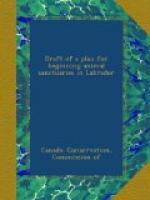and further north. Seals are diminishing.
Whales are beginning to disappear. Fur-bearing
animals can hardly hold their own much longer in face
of the ever increasing demand for their pelts and
the more systematic invasion of their range. The
opening up of the country in the north will mean the
extinction of the great migrating herd of barren-ground
caribou, unless protection is enforced. The coast
birds are going fast. Some very old men can still
remember the great auk, which is now as extinct as
the dodo. Elderly men have eaten the Labrador
duck, which has not been seen alive for thirty years.
And young men will certainly see the end of the Hudsonian
and Eskimo curlews very soon, under present conditions.
The days of commercial “egging” on a large
scale are over, because eggs of the final lay were
taken like the rest, and the whole bird life was depleted
below paying quantities. But “egging”
still goes on in other ways, especially at the hands
of Newfoundlanders, who are wantonly wasteful in their
methods, unlike the coast people, who only take what
the birds will replace. The Newfoundlanders and
other strangers gather all the eggs they see, put
them into water, and throw away every one that floats.
Thus many more bird lives are destroyed than eggs
are eaten or sold, because schooners appear towards
the end of the regular laying season, when most of
the eggs are about to hatch out—and these
are the ones that float. But even greater destruction
is done when a schooner stays several days in the
same place. For then the crew go round, first
smashing every egg they see, and afterwards gathering
every egg they see, because they know the few they
find the second time must have been newly laid.
Many details were given of other forms of destruction,
and some details of the revolting cruelties practised
there, as in every other place where wild life is
grossly abused instead of being sanely used. All
classes of legitimate human interest were dealt with
in turn; and it was shown that the present system—or
want of system—was bad for each one:
bad for such wild life as must still be used for necessary
food, bad for every kind of business in the products
of wild life, bad for the future of sport, bad for
the pursuits of science, and bad for the prospects
of wild “zoos”. The Address
ended with a plea for conservation, and pointed out
that the only class of people who could possibly be
benefitted under present conditions were those who
were ready to destroy both the capital and interest
of any natural resources for the sake of snatching
a big and immediate, but really criminal, profit.
The Address was sent out for review to several
hundreds of general and specialist newspapers, and,
thanks to the expert help so freely given me, ran
the gauntlet of the press without finding one dissentient
voice against it. Copies were also sent to every
local expert known, as well as to those experts in
the world outside who were the most likely to be interested.
Three classes of invaluable expert opinion were thus
obtained for the Supplement. The first
class may be called experts on Labrador; the second,
experts on wild life in general; and the third, experts
on the public aspects of the question. All three
were entirely in favour of general conservation for
the whole of Labrador and the immediate establishment
of special sanctuaries, as recommended in the Address.




